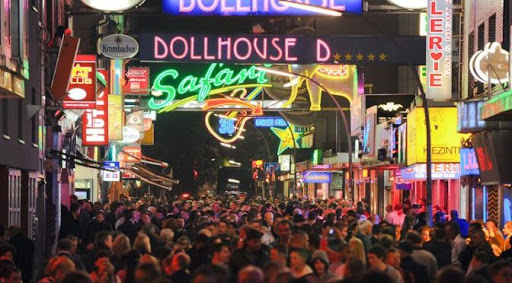Being a student in Hamburg
Hamburg is one of Germany’s largest metropolises, a northern port city of about two million inhabitants. When I say harbor, don’t think that it has a sea coast. Although some might consider it a sea, the city is located at the point where the Elbe River meets the North Sea. The Baltic Sea is 40 minutes away to the north east. The city harbor is on the Elbe River, but it is Germany’s largest port and the gateway to the world. Since we had the opportunity to visit the city more than once, I will try to share our impressions. Although it is said that there are more bridges in the city than Venice, we did not have the opportunity to count them 🙂
Hamburg is one of Germany’s largest metropolises, a northern port city of about two million inhabitants. When I say harbor, don’t think that it has a sea coast. Although some might consider it a sea, the city is located at the point where the Elbe River meets the North Sea. The Baltic Sea is 40 minutes away to the north east. The city harbor is on the Elbe River, but it is Germany’s largest port and the gateway to the world. Since we had the opportunity to visit the city more than once, I will try to share our impressions. Although it is said that there are more bridges in the city than Venice, we did not have the opportunity to count them 🙂
Hamburg is considered a metropolis on the scale of Germany. (For those who live in mega cities, it can even be called a small city, but since the cities in Germany are very small, cities with a population of millions can be considered as metropolises) Being a port city, its cosmopolitan character is reflected in its culture and entertainment. The Saint Pauli neighborhood, whose fame has long gone beyond the borders of the country, is the most well-known part of Hamburg with its various entertainment venues, red light street and never-ending tourists.
We love Hamburg because we are used to the big city. Another beauty of the city, similar to Istanbul and being a port city, is the famous Fish Market. The freshest fish caught in the North Sea is sent all over the country from here. Watching the auctions early in the morning and having breakfast here is an alternative way to start the day well. Of course, the quality of life is one of the things that attracts students to the city, but the 9 public universities in the city, the variety of programs that are even difficult to pronounce, the subjects ranging from technology to performing arts and the quality of education are also a factor. The most prominent universities are the University of Hamburg and the Technical University of Hamburg.
The positive side effect of this wide choice of universities is an active student life on the one hand, and opportunities for research and further education on the other. In addition to education, job opportunities and the option to start your career here make the city even more attractive. The city is very modern and offers everything you would expect from a big city. I have to say it is a bit expensive, but not as expensive as Munich. For students, the options can be more plentiful. Students could eat in the university canteens (Menza) for 1,80 Euros. I didn’t eat there but my son has experienced it and I didn’t hear him complaining about the quality of the food.

LIFE IN HAMBURG
I mentioned that Hamburg is a bit expensive, but one of the positives of being a big city is that there is a lot of choice in terms of food and accommodation. It is possible to find options for every budget. Even though the general problem of big cities is the lack of state dormitories, there are many shared or private apartment alternatives. When the city is big, transportation is not very problematic. For those of us who are used to living in a big city, it is very easy to adapt. Hamburg-Horn, in particular, is well connected to the city center by metro and is therefore popular with students.
At the time of writing this blog, with a simple search, I was able to find many places for rent for around 450-550 Euros per month. Of course, take into account that at the time I am writing this, it is the pandemic period and the end of the semester. Otherwise Hamburg competes with Munich every year in terms of high rents. State dormitories provide accommodation for roughly 4400 students in 26 housing complexes, while there are also many private dormitory options. Below is a link to public and private dormitories.
https://www.studierendenwerk-hamburg.de/wohnen/wohnanlagen
In addition, you can find advertisements that you will not find elsewhere on https://www.ebay-kleinanzeigen.de/anzeigen/s-wohnung-mieten/hamburg/wohnung/k0c203l9409.
Please Note !!! Be suspicious of commission-free apartments, photos that look like hotel rooms and utopian low rental prices: they are often fake. You should also always be suspicious of landlords who are supposedly based abroad and demand money before you even see the apartment.
Let’s face it, Hamburg has a wetter climate than London. Especially in November, when the wind blows five degrees of rain horizontally in your face, you might wish you were in a more southern city. But as a student you will spend most of your time in class or in the library. I think bad weather will motivate you more to study, especially when the sun is shining. There is a joke about this subject. “I spent a month in Hamburg a few years ago and it rained only twice – once for 13 days and once for 16 days.”

The main campus of the University of Hamburg, close to the Dammtor S-Bahn station. It is not only very central, but also right next to the large Planten un Blomen gardens (Flower Garden). Thousands of flowers are planted here every year and it is colorful from April to October. This magnificent park is full of students who want to study in nature and make you forget that you are in the middle of a big city. As a reminder, it’s best to walk from the station to get here, but you can also take bus number 5 to the campus, but don’t make the mistake: it’s the bus line with 50,000 passengers a day, making it the busiest in Europe.
HAMBURG BY THE NUMBERS
| City Population | 1.847.253 |
| Number of Students | 110.220 |
| Student/resident ratio | % 6 |
| Number of beds provided by Studierendenwerk | 4.400 |
| Rents for accommodation provided by Studierendenwerk | 244-415 € |
Did I help you? If you have any questions, you will probably find the answer on these pages, but you can still contact me at recep[at]recepdayi.com.tr and on my social media accounts. I try to improve my articles according to your feedback, so please send me your comments. Thank you in advance.




